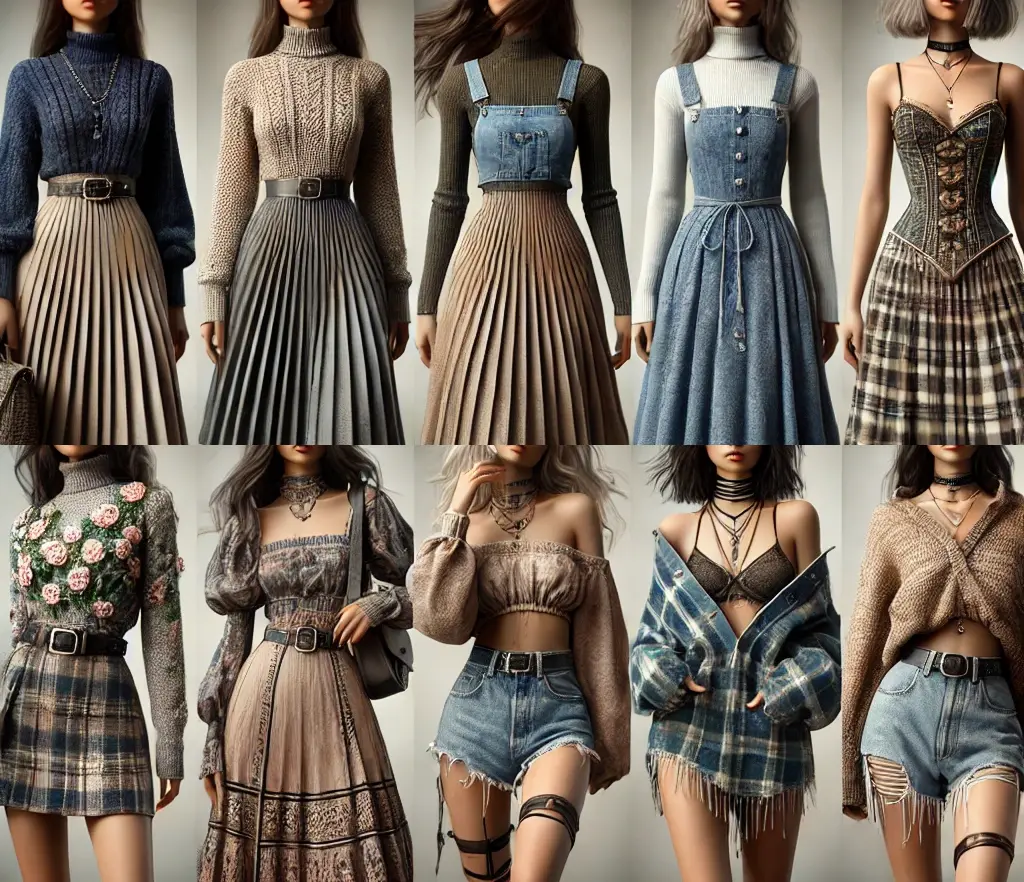
Fashion is ever-changing, with styles evolving from classic high fashion to bold, unusual trends. Today, the fashion industry moves fast, and brands must adapt quickly to stay relevant. PLM software helps designers track emerging trends, streamline product design, and optimize production.
This article explores different types of fashion styles, including aesthetic fashion styles, high fashion style, and unique styles. It also explains how PLM systems help brands embrace innovation in real-time.
The Many Types of Fashion Styles
Fashion embraces variety, allowing people to express their personal style through different aesthetics. Here are some popular types of fashion styles:
1. Designer Fashion Style
This style represents luxury, exclusivity, and innovation. High-end brands showcase their collections at fashion week, setting global trends. Designer fashion style includes structured silhouettes, clean lines, and premium materials like silk and leather jackets.
High fashion style is not just about clothing—it’s a statement of craftsmanship and status. Iconic designers influence trends that trickle down to mainstream fashion, shaping the industry for years.
2. Aesthetic Fashion Styles
Aesthetic fashion styles emphasize visual storytelling and self-expression, allowing individuals to curate their identity through clothing. These styles often draw inspiration from specific time periods, subcultures, or artistic movements, blending elements of nostalgia, fantasy, and cultural influences into everyday wear. Here’s a deeper look at some of the most popular aesthetic fashion styles:
Dark Academia
Dark Academia is a sophisticated, intellectual fashion aesthetic inspired by vintage European fashion, classical literature, and the romanticism of academia. This style draws heavily from the aesthetics of old libraries, ivy-covered universities, and scholarly pursuits.
- Muted and earthy tones – Shades of brown, black, beige, and deep green dominate this look, reflecting a vintage academic atmosphere.
- Classic and layered pieces – Turtlenecks, pleated skirts, blazers, and wool cardigans create a timeless, elegant silhouette.
- Textured fabrics – Tweed, wool, and corduroy contribute to the classic, bookish aesthetic.
Dark Academia fashion pairs well with an interest in poetry, philosophy, and classic literature, making it a deeply immersive aesthetic beyond just clothing.
Y2K Fashion
Y2K fashion brings a nostalgic yet futuristic throwback to the early 2000s, characterized by bold, playful, and tech-inspired elements. It reflects the optimism of the digital era with flashy, eye-catching designs.
- Shiny and synthetic fabrics – Vinyl, metallics, and satin dominate Y2K outfits, giving them a futuristic edge.
- Statement pieces – Mini skirts, crop tops, wide-leg pants, and low-rise jeans define the look.
- Playful accessories – Chunky sunglasses, butterfly clips, and platform sneakers complete the aesthetic.
Y2K fashion draws inspiration from pop culture, including early 2000s celebrities, music videos, and films that celebrated bright colors and experimental fashion.
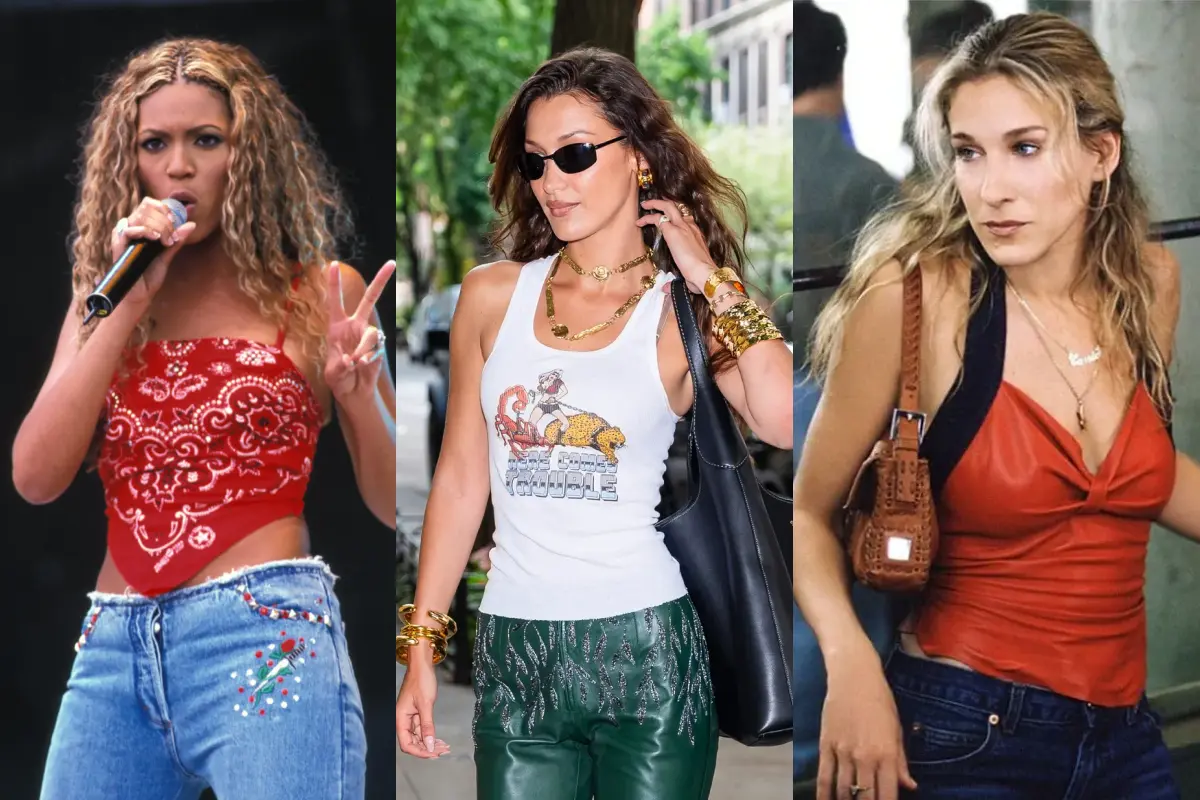
Boho Chic
Boho Chic is a relaxed, free-spirited aesthetic that merges bohemian influences with modern style. This look draws inspiration from the 1960s and 1970s counterculture, emphasizing individuality and effortless beauty.
- Flowing silhouettes – Maxi dresses, loose tunics, and flared pants provide comfort and movement.
- Earthy and neutral tones – Shades of brown, cream, olive, and rust dominate this aesthetic.
- Intricate details – Embroidery, crochet, fringe, and layered jewelry add artistic touches.
Boho Chic fashion is often associated with music festivals, artistic expression, and a laid-back, nature-inspired lifestyle.
Grunge
Grunge fashion is an effortlessly cool and rebellious aesthetic rooted in 1990s rock culture. Inspired by bands like Nirvana and Pearl Jam, this style embraces a disheveled, undone look.
- Ripped and distressed fabrics – Oversized flannels, ripped jeans, and band t-shirts are wardrobe staples.
- Dark and moody colors – Black, grey, deep red, and army green define the grunge palette.
- Layering and texture – Leather jackets, fishnet stockings, and combat boots add a raw, edgy feel.
Grunge fashion thrives on an anti-establishment attitude, making it a lasting symbol of rebellion and individuality.
3. Unusual Fashion Styles
Fashion pushes boundaries with bold, unconventional designs. Some unusual fashion styles include:
Avant-Garde
Avant-garde fashion is all about experimentation and artistic innovation. Designers in this category prioritize creativity over wearability, often producing statement pieces that challenge societal norms.
- Exaggerated silhouettes – Think oversized shoulders, asymmetrical designs, and abstract draping.
- Unconventional materials – Plastic, metal, and recycled materials frequently appear in avant-garde collections.
- Cultural and political messaging – Many avant-garde pieces serve as social commentary, reflecting on issues like climate change, identity, or technology.
Fashion designers such as Rei Kawakubo and Iris van Herpen have mastered this art, transforming fashion into a visual spectacle rather than just everyday clothing.
Gothic Fashion
Gothic fashion draws inspiration from Victorian mourning attire, gothic literature, and the darker aesthetics of punk and alternative culture. It is a style deeply associated with mystery, rebellion, and a fascination with the macabre.
- Dark color palettes – Black dominates, but deep reds, purples, and metallics also play a role.
- Dramatic layering – Corsets over blouses, lace-up boots, flowing cloaks, and long skirts create a mysterious aura.
- Luxurious textures – Velvet, lace, leather, and satin add richness to gothic outfits.
Gothic fashion has many subgenres, including Victorian Goth, Cybergoth, and Romantic Goth, each with its own twist on the dark and elegant aesthetic.
Cyberpunk
Cyberpunk fashion fuses futuristic technology with urban streetwear. This edgy, tech-driven style is inspired by dystopian themes, sci-fi movies, and digital culture.
- Neon accents and metallic fabrics – Cyberpunk looks often feature bright neon colors contrasting with darker tones like black and grey.
- High-tech accessories – Augmented reality glasses, LED-lit clothing, and wearable tech integrate seamlessly into this aesthetic.
- Utility-driven designs – Cargo pants, asymmetrical jackets, and harnesses add a functional yet fashionable touch.
Cyberpunk fashion has gained popularity thanks to media like Blade Runner, The Matrix, and video games like Cyberpunk 2077.
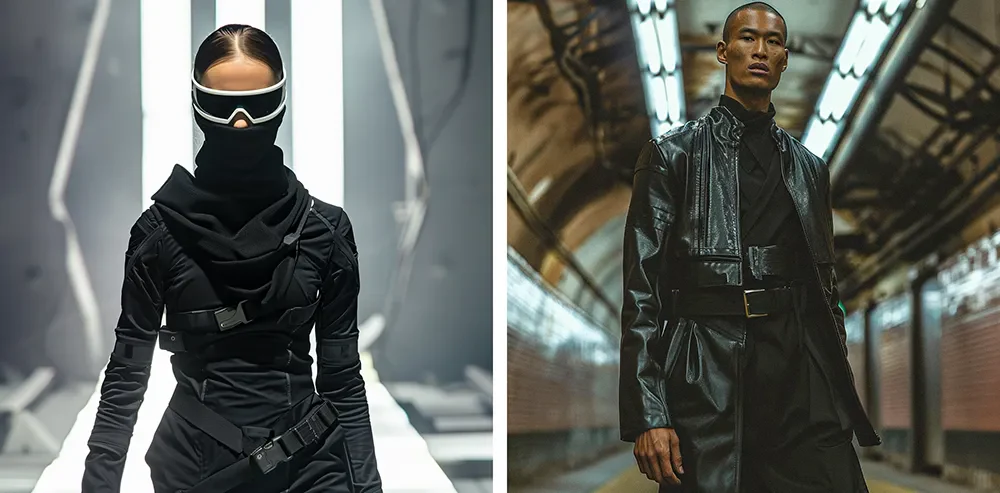
Steampunk
Steampunk fashion is a fascinating blend of Victorian elegance and industrial revolution-era mechanics. It merges historical elements with futuristic imagination, often seen in cosplay, conventions, and period-inspired fashion events.
- Victorian-inspired garments – Corsets, waistcoats, bustled skirts, and frock coats are staples of steampunk fashion.
- Industrial accessories – Gears, goggles, top hats, and mechanical-looking jewelry contribute to the aesthetic.
- Muted color schemes – Browns, brass, and sepia tones dominate, mimicking the look of aged machinery.
Steampunk allows for a mix of elegance and adventure, appealing to those who enjoy both vintage and sci-fi influences.
4. Different Types of Fashion Styles for Women
Women’s fashion spans various styles, from casual to formal. Some key elements include:
- Casual Streetwear – Comfortable yet stylish outfits featuring cargo pants, oversized tees, and sneakers. Streetwear often incorporates limited-edition designs and collaborations with artists.
- Business Chic – Clean lines, structured blazers, and pencil skirts for a polished, professional look. Monochrome palettes and neutral tones dominate this style.
- Romantic Style – Feminine silhouettes like pleated skirts, lace details, and soft pastels. Floral patterns, ruffles, and flowing fabrics define this look.
- Athleisure – A fusion of athletic wear and casual fashion, featuring leggings, hoodies, and sneakers designed for both comfort and style.
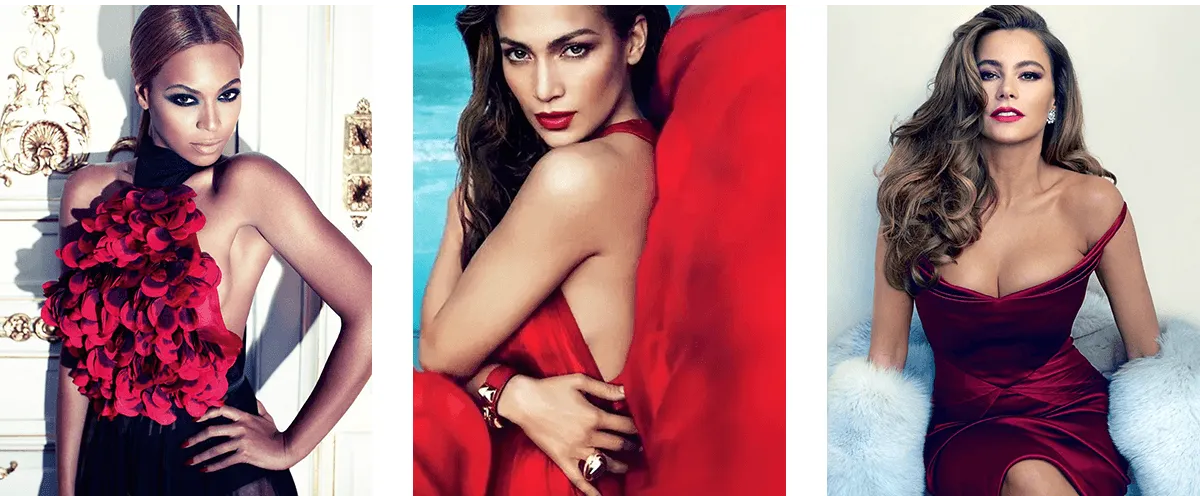
How PLM Software Drives Fashion Trend Adoption
Fashion trends emerge fast, often influenced by social media and celebrity culture. PLM software helps brands respond to trends efficiently by enabling real-time collaboration, streamlined product design, and reduced costly production errors.
1. Real-Time Trend Tracking
PLM systems allow brands to track social media trends, consumer preferences, and runway inspirations. Designers can analyze data to predict upcoming trends, ensuring their collections remain relevant. This ability to identify emerging styles allows brands to stay ahead of competitors.
2. Streamlined Product Design
With fashion PLM software, teams can create, modify, and refine designs seamlessly. This digital workflow speeds up the development of trend-driven pieces like mini skirts, leather jackets, or wide leg pants. Designers can experiment with new silhouettes, materials, and colors without logistical delays.
3. Reduced Costly Mistakes
Mistakes in product development lead to wasted materials and delays. PLM software minimizes errors by centralizing all design elements, from sketches to fabric details. This helps brands maintain efficiency and sustainability. By tracking design iterations, teams can optimize production workflows and ensure accuracy.
4. Faster Prototyping and Production
High fashion brands and retailers need quick turnarounds to stay competitive. PLM systems streamline communication between designers, manufacturers, and suppliers, ensuring rapid production of trend-driven garments like crop tops and cargo pants. By automating sample approvals and material sourcing, brands reduce time-to-market.
5. Efficient Inventory Management
Overproduction and underproduction are costly mistakes in the fashion industry. Apparel PLM software integrates demand forecasting, helping brands produce the right amount of inventory. This prevents waste and ensures optimal stock levels.
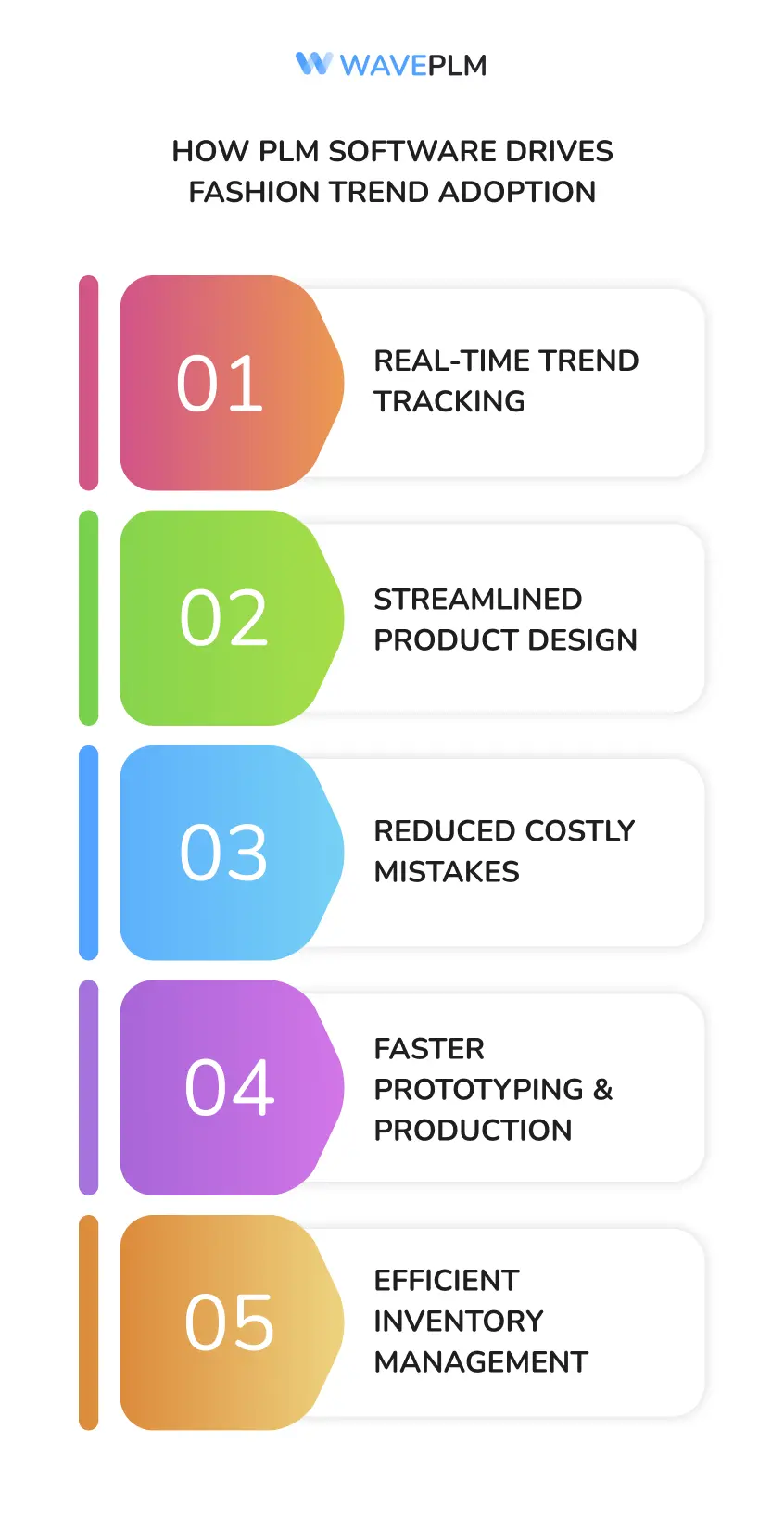
The Role of PLM Systems in Fashion Innovation
PLM software is more than a design tool—it’s a game-changer for trend-driven fashion. Here’s how it impacts innovation:
- Enhanced Collaboration – Teams across different locations can work on the same project simultaneously, reducing delays and miscommunication.
- Data-Driven Decisions – Designers use insights from previous collections to refine future trends. Analytics help identify which styles are most profitable and which need reworking.
- Sustainability Integration – PLM systems help brands track eco-friendly materials and ethical sourcing. Companies can monitor their supply chains for compliance with sustainable practices.
- Customization Capabilities – Brands can use PLM to develop personalized products, allowing customers to mix and match designs, colors, and materials.
- Faster Trend Implementation – fashion PLM streamlines the process of turning trend reports into real products, allowing brands to capitalize on fleeting fashion moments.
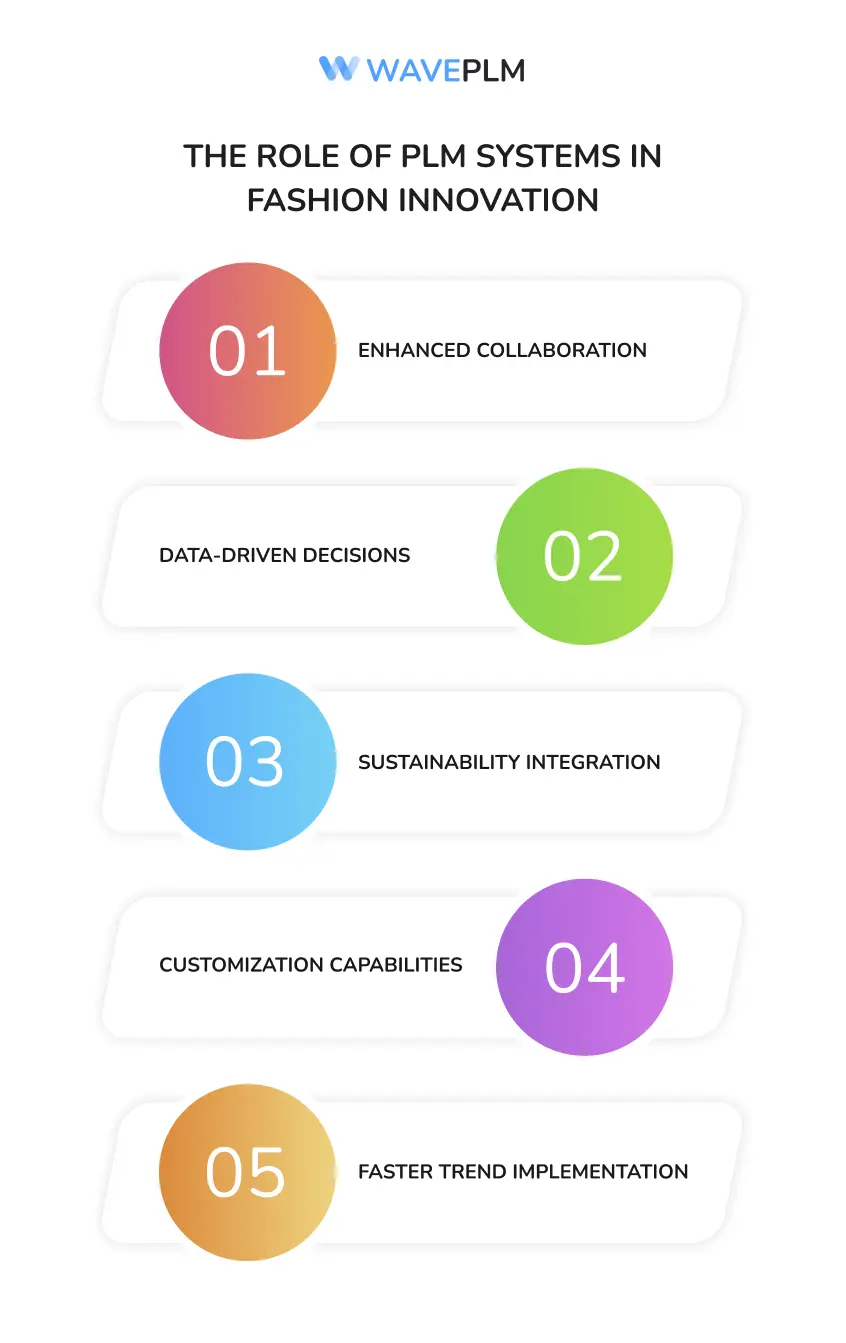
Conclusion
Fashion thrives on evolution, and brands must embrace change to remain relevant. From designer fashion style to unusual fashion styles, staying ahead requires agility. PLM software empowers brands to adopt new trends, optimize product design, and enhance collaboration. In a fast-paced industry, integrating fashion PLM systems ensures efficiency, creativity, and long-term success.
By leveraging real-time insights and structured workflows, fashion companies can transform ideas into market-ready products with confidence. Whether crafting high fashion style or aesthetic fashion styles, PLM software is the key to driving innovation in modern fashion.
The ability to track, analyze, and implement trends efficiently ensures that brands can consistently deliver fresh, exciting collections that resonate with consumers worldwide.





Leave a Reply